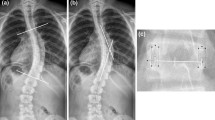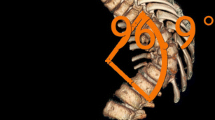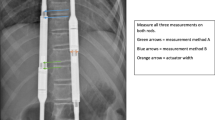Abstract
Purpose
The Cobb angle method is used to determine the severity of scoliosis. Therapeutic decisions for adolescent idiopathic scoliosis (AIS) are guided by the Cobb angle. Therefore, high reliability is crucial. The objective of this study was to determine the intra- and inter-observer reliability of the digital Cobb angle measurements and the definition of end vertebrae in patients with AIS. Moreover, the influence of the observer’s medical specialty and experience on Cobb angle measurement was evaluated.
Methods
Intra- and inter-observer reliability of the digital Cobb angle and end vertebrae is assessed in postero-anterior radiographs of 39 patients with AIS. Measurements were performed blinded and twice by six observers, with a two to 3 week interval. Intra- and inter-observer reliability was analysed by means of intraclass correlation coefficients (ICC).
Results
Both intra- and inter-observer reliability analyses resulted in ICC’s higher than 0.864 for the Cobb angle and definition of end vertebrae. In addition, for the observer’s experience and medical specialty group the inter-observer ICC’s were higher than 0.984. The average inter-observer variability for the Cobb angle were 3°, and 1.1–1.6 levels for the cranial and caudal end vertebrae selection. The variability in measured Cobb angle was 1° for the experience group and 2° for the medical specialty group. Cronbach’s alpha varied from 0.990 to 0.996. Bland–Altman plots showed moderate variation with a few outliers.
Conclusions
The digital Cobb angle measurement as well as the definition of end vertebrae show excellent reliability. According to our results, medical specialty and experience do not affect Cobb angle measurements and definition of end vertebrae.




Similar content being viewed by others
References
Konieczny MR, Senyurt H, Krauspe R (2013) Epidemiology of adolescent idiopathic scoliosis. J Child Orthop 7(1):3–9
Canavese F, Turcot K, De Rosa V et al (2011) Cervical spine sagittal alignment variations following posterior spinal fusion and instrumentation for adolescent idiopathic scoliosis. Eur Spine J 20(7):1141–1148
Théroux J, Le-May S, Hebert JJ et al (2017) Back pain prevalence is associated with curve-type and severity in adolescents with idiopathic scoliosis. Spine (Phila Pa 1976) 42(15):914–919
Horne JP, Flannery R, Usman S (2014) Adolescent idiopathic scoliosis: diagnosis and management. Am Fam Phys 89(3):193–198
Griffet J, Leroux MA, Badeaux J et al (2000) Relationship between gibbosity and Cobb angle during treatment of idiopathic scoliosis with the SpineCor brace. Eur Spine J 9(6):516–522
Goldberg CJ, Dowling FE, Fogarty EE (1993) Adolescent idiopathic scoliosis: is rising growth rate the triggering factor in progression? Eur Spine J 2(1):29–36
Biondi J, Weiner DS, Bethem D et al (1985) Correlation of Risser sign and bone age determination in adolescent idiopathic scoliosis. J Paediatr Orthop 5(6):697–701
Cobb JR (1948) Outlines for the study of scoliosis. Instr Course Lect 5:261–272
Langensiepen S, Semler O, Sobottke R et al (2013) Measuring procedures to determine the Cobb angle in idiopathic scoliosis: a systematic review. Eur Spine J 22(11):2360–2371
Gstoettner M, Sekyra K, Walochnik N et al (2007) Inter- and intraobserver reliability assessment of the Cobb angle: manual versus digital measurement tools. Eur Spine J 16(10):1587–1592
Lonstein JE, Carlson JM (1984) The prediction of curve progression in untreated idiopathic scoliosis during growth. J Bone Joint Surg Am 66(7):1061–1071
Lechner R, Putzer D, Dammerer D et al (2017) Comparison of two- and three-dimensional measurement of the Cobb angle in scoliosis. Int Orthop 41(5):957–962
Aubin CE, Bellefleur C, Joncas J et al (2011) Reliability and accuracy analysis of a new semiautomatic radiographic measurement software in adult scoliosis. Spine (Phila Pa 1976) 36(12):780–790
Zhang J, Lou E, Shi X et al (2010) A computer-aided Cobb angle measurement method and its reliability. J Spinal Disord Tech 23(6):383–387
McAlinden C, Khadka J, Pesudovs K (2015) Precision (repeatability and reproducibility) studies and sample-size calculation. J Cataract Refract Surg 41(12):2598–2604
Field A (2009) Discovering statistics using SPSS, 3rd edn. Sage Publications Ltd, London
Koo TK, Li MY (2016) A Giudeline of selecting and reporting intraclass correlation coefficients for reliability research. J Chiropr Med 15:155–163
Bland JM, Altman DG (1997) Statistic notes Cronbach’s alpha. BMJ 314:572
Jones M, Dobson A, O’Brian S (2011) A graphical method for assessing agreement with the mean between multiple observers using continuous measures. Int J Epidemiol 40:1308–1313
Carman DL, Browne RH, Birch JG (1990) Measurement of scoliosis and kyphosis radiographs. Intraobserver and interobserver variation. J Bone Joint Surg Am 72(3):328–333
Morrissy RT, Goldsmith GS, Hall EC et al (1990) Measurement of the Cobb angle on radiographs of patients who have scoliosis. Evaluation of intrinsic error. J Bone Joint Surg Am 72(3):320–327
Wu W, Liang J, Du Y et al (2014) Reliability and reproducibility analysis of the Cobb angle and assessing sagittal plane by computer-assisted and manual measurement tools. BMC Musculoskelet Disord 15:33
Villemure I, Aubin CE, Grimard G et al (1976) Progression of vertebral and spinal three-dimensional deformities in adolescent idiopathic scoliosis: a longitudinal study. Spine 26(20):2244–2250
Acknowledgements
We would like to thank Helene Gendera, Dave van Iersel and Sander Sassen for their contribution to this study.
Funding
No funds, grants, or other support was received.
Author information
Authors and Affiliations
Contributions
All authors contributed to the study conception and design. Material preparation and data collection were performed by FGP and JJN. Analysis was performed by all authors. The first draft of the manuscript was written by FGP, and all authors were commented on the previous versions of the manuscript. All authors read and approved the final manuscript.
Corresponding author
Ethics declarations
Conflicts of interest
The authors have no conflicts of interest to declare which are relevant to the content of this article.
Ethical approval
Ethical approval was waived by the local Ethics Committee of University A in view of the retrospective nature of the study, and all the procedures being performed were part of the routine care.
Additional information
Publisher's Note
Springer Nature remains neutral with regard to jurisdictional claims in published maps and institutional affiliations.
Rights and permissions
About this article
Cite this article
Prestigiacomo, F.G., Hulsbosch, M.H.H.M., Bruls, V.E.J. et al. Intra- and inter-observer reliability of Cobb angle measurements in patients with adolescent idiopathic scoliosis. Spine Deform 10, 79–86 (2022). https://doi.org/10.1007/s43390-021-00398-0
Received:
Accepted:
Published:
Issue Date:
DOI: https://doi.org/10.1007/s43390-021-00398-0




